Destination
Destination
Right in the heart of the Zagros Mountains, Lorestan houses last vestiges of being one of the first civilizations and human habitats. It is immersed with natural beauties like so many mysterious waterfalls and canyons. Besides, it is featured with wheat fields and oak trees. Despite all the authentic and untouched landscapes Lorestan offers its visitors, it has been neglected by tourists. So if you are more of non-touristic sites with the untouched and mesmerizing landscapes, Lorestan is your perfect choice.
Gahar Lake, Falak-ol-Aflak Castle, Bisheh Waterfall, Shirz Canyon, and Goldasht Valley are only some of the countless natural landscapes of Lorestan Province.
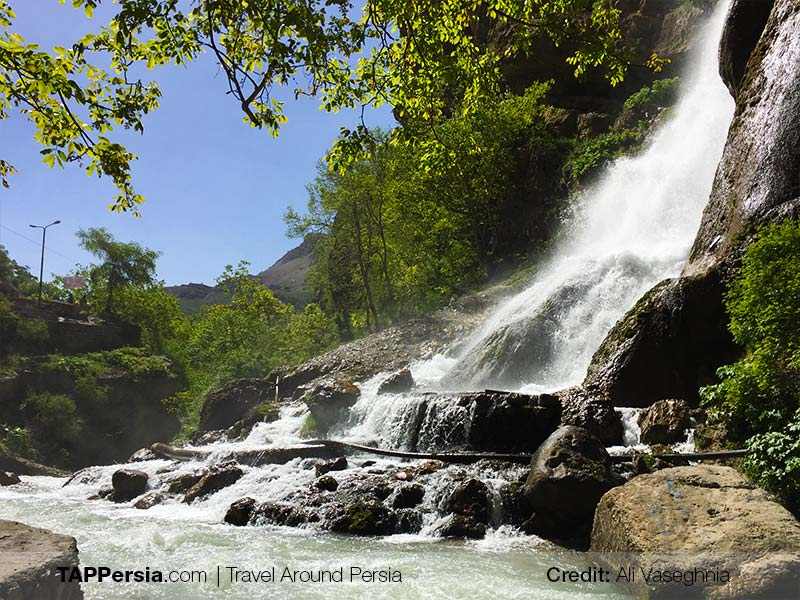
Khoram Abad, Broujerd, Aligoudarz, and Kuhdasht are the chief cities of this province where you can find various untouched attractions. While visiting there, do not miss on their famous Kebabs since they have high-quality meat.
Due to being right in the heart of mountain ranges, it is better to pick a season for your travel which is not too cold or too hot so that you’d be able to make the most out of your stay. Since Lorestan has mesmerizing waterfalls, rivers, and canyons, it is better to visit there during October, November, and from March to May because you will need to cross so many rivers. So, not only will it shade for you to get rests in the canyons, but also it will not be too cold to make passing rivers and waterfalls so difficult.
30-Day Iran Visa Delivered in 3 Days
The safe solution
The freedom to explore Iran
The fastest, most reliable & efficient
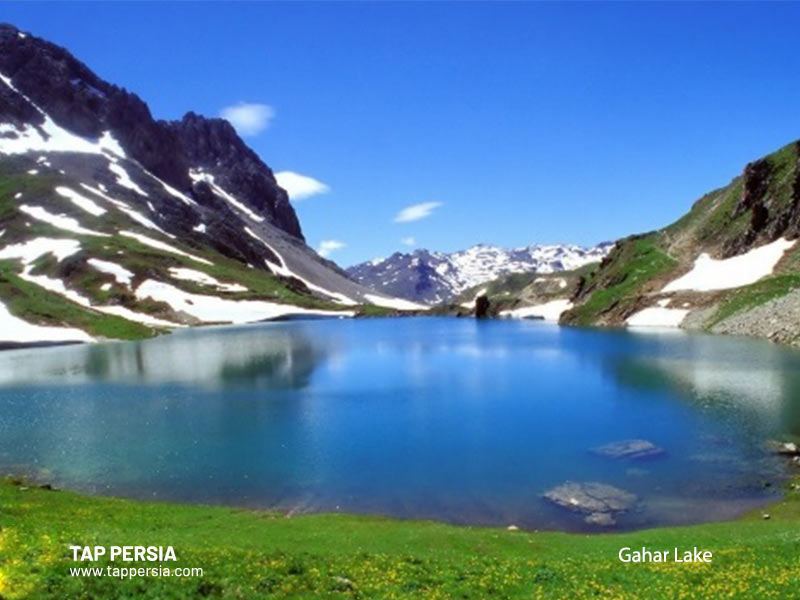
Gahar Lake is known as the jewel of Oshtrankooh Mount and as one of the most beautiful lakes in Iran. Annually, it receives thousands of tourists from all over the country. This freshwater lake is home to a variety of plant and animal species. In addition to its clear and transparent water, it has clean and unique air and is, therefore, an ideal place for camping.
Gahar consists of two parts, Gohar-e Bozorg (Big Gahar) and Gahar Kouchak (small Gahar). The beach of this lake is rocky in most parts. More importantly, it is possible to swim in the parts with sandy beaches. You can find Gahar Lake in the protected area of Oshtrankooh and on the border of Aligudarz, Doroud, and Azna.
Khazineh Canyon is another wonder of Lorestan province that is comparable to the Grand Canyon of America for some visitors. This valley is located in the middle of Poldakhtar-Andimeshk road in Khazineh village. It is a great place for mountaineering and rock climbing which can be so much exciting.
In fact, access to this canyon is possible with several hours of walking. And as a result, it is necessary to use appropriate shoes and hats for the long walk under the sun. Preferably postpone visiting this amazing masterpiece of nature until the first half of spring and the beginning of autumn.
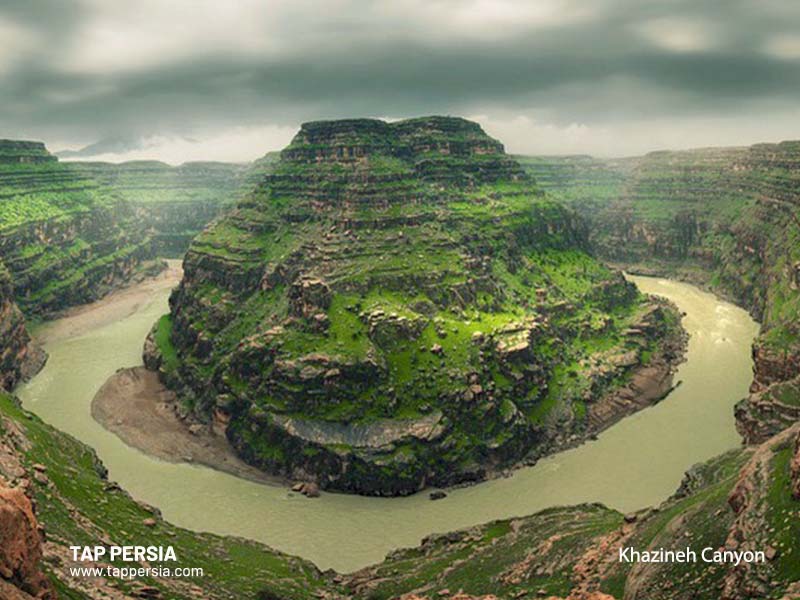 There is an old bridge 112 meters long and 85 meters high in this valley. Brave people prefer to experience crossing this suspension bridge. The great river of Seymareh passes through this valley and this has caused the erosion of the rocks of the valley over time. And for the same reason, the rocks have special shapes. They say the horseshoe twist is the most important and attractive part of the valley that surprises every viewer.
There is an old bridge 112 meters long and 85 meters high in this valley. Brave people prefer to experience crossing this suspension bridge. The great river of Seymareh passes through this valley and this has caused the erosion of the rocks of the valley over time. And for the same reason, the rocks have special shapes. They say the horseshoe twist is the most important and attractive part of the valley that surprises every viewer.
Bisheh waterfall (Iran tourism places) is one of the most beautiful sights in Lorestan, which is also on Iran’s National Natural Heritage List. You can visit this waterfall, 60 km from Khorramabad.
Its 48 meters height makes it very attractive for tourists. Since Bisheh waterfall is located in the highlands, the best time to visit it is spring and summer.
You can visit Keeyow natural lake with an area of seven hectares and a depth of three to seven meters right in the middle of Khorramabad city. Fortunately, it is easily accessible for all tourists. The lake is blue due to the presence of certain plant species on its bottom. Keeyow in Lori means dark blue, that’s why they call it Keeyow lake.
Boating with motorboats, pedal boats, jet boats, and musical boats is possible on Q Lake. The small amusement park by the lake is also the choice of some tourists to use games such as ball pool, trampoline, Eurobanji, etc. In addition, every year a number of migratory birds come to this lake, and watching them (in the right season) is very enjoyable.
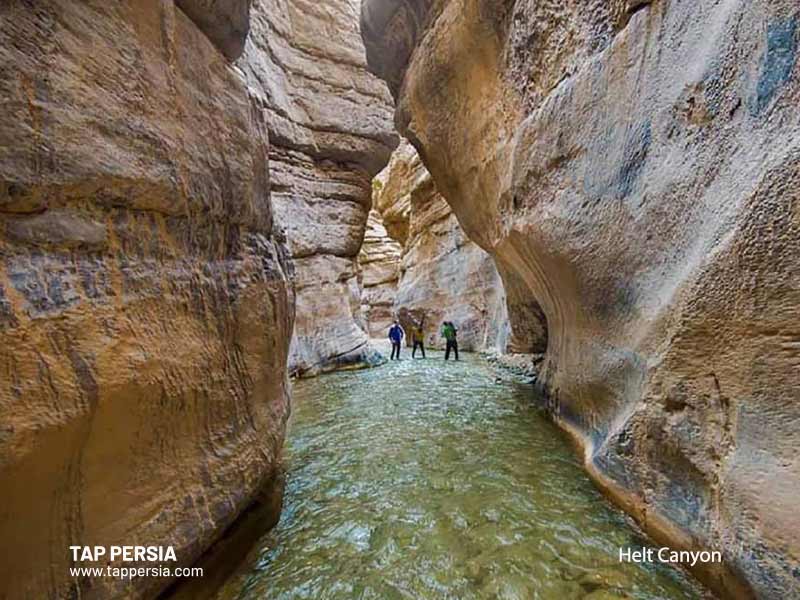 Helt Poldakhtar Canyon is the choice of many hikers, rock climbers, and people interested in exciting experiences. The Helt canyon is about four kilometers long and takes about four to five hours to get around. Therefore, to visit it, you need to have the appropriate physical preparations.
Helt Poldakhtar Canyon is the choice of many hikers, rock climbers, and people interested in exciting experiences. The Helt canyon is about four kilometers long and takes about four to five hours to get around. Therefore, to visit it, you need to have the appropriate physical preparations.
If you wish, you can bathe in the heart of wild nature and get rid of the tiredness of daily life. The best time to visit the Strait of Helt is late summer and early fall. These times are when it’s not too hot.
This natural phenomenon was formed by millions of years of water erosion. The locals say at the entrance of the canyon, in the past, there was a dam or a lake; However, due to the flood, the water opened its way.
The overturned tulip or Fritillary plain of Aligudarz is located in the heart of the Zagros Mountains. These plains include mountainous areas with an area of 2,900 hectares. In May, this plain dazzles the eyes with its overturned tulips and creates a paradise that may not be found anywhere else. Lilium ledebourii is also among the overturned tulips of this region that are worth seeing.
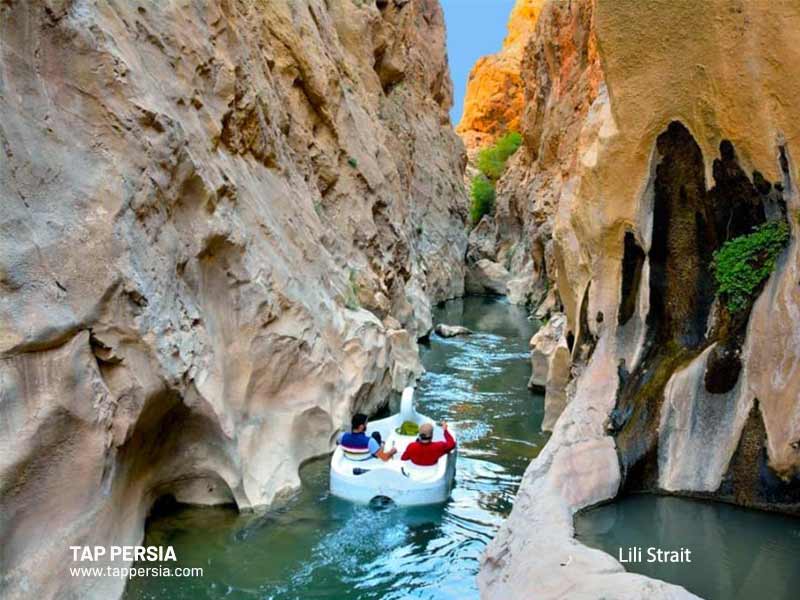
Lili Doroud Strait is the result of the erosion caused by the Marbore River. The result of erosion is the formation of smooth and polished rocks that evoke the Star Valley of Qeshm. This strait has a lot of water and that is why many tourists do not neglect swimming, playing water, and even diving in its water. Boating is another common pastime in the strait that you have to pedal in the narrow rocky space!
Shirz Canyon or Shirez Valley or canyon is located in Zardalan of Kuhdasht. This five-kilometer valley is one of the most special geological forms in Iran and from springs to waterfalls and beautiful rivers are among the sights of this valley. Meanwhile, one of the water caves in Lorestan province, Pol Khoda, is located at the end of this valley. Interestingly, they have discovered ancient sites with signs of cave life in this place. As the nature and climate of this region are unique in spring, it is the best time to visit Shirz Valley.
Baranjeh or Taf waterfall is another natural attraction of Lorestan, near the historical village of Pir Imam in the Shool Abad area. This seasonal waterfall, which is estimated to be between 200 and 800 meters high, flows from the top of the mountain to the Taf grove, creating a pure effect. Baranjeh is a stepped waterfall with three floors, which reaches its maximum flow in early spring.
There is various vegetation around the river including walnut trees, wild figs, wild grapes, etc. which double the charm of the area. If you are planning to visit this waterfall, May will be the best time. In May not only you will see this amazing waterfall but also a beautiful plain of overturned tulips near it. And it will be a completely different tourist experience for you.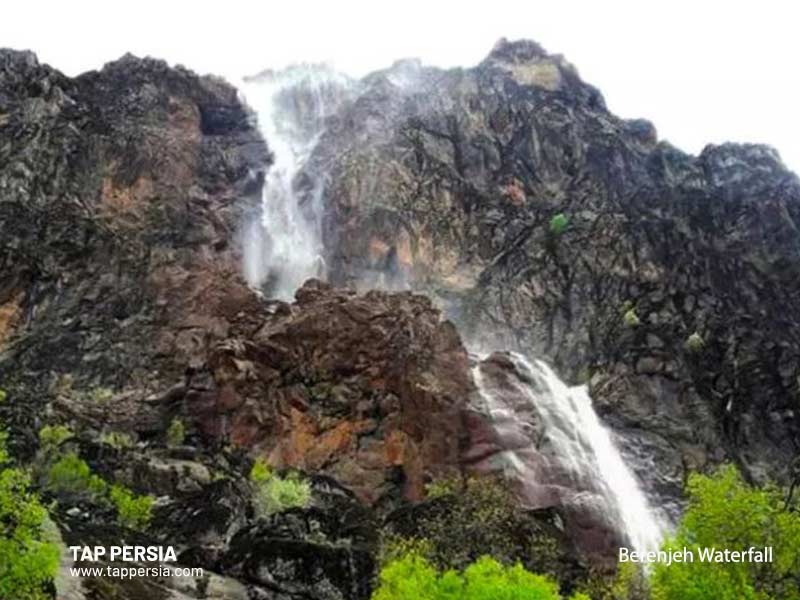
Afrineh waterfall is one of the most outstanding waterfalls in Lorestan. It is unique due to its water falling through wide cliffs. You can visit this waterfall in Afrineh village in Poldakhtar city. The easy access to this waterfall is one of the reasons that many tourists visit this place.
Afrineh includes several waterfalls, the highest of which reaches a height of about 20 meters. There is a very large pool at the bottom of the waterfall that is always full of water and you can bathe in it. This natural attraction is so amazing that you will be immersed in its beauty and enjoy the wonderful climate around it.
Kalmakreh Cave is one of the sights of Lorestan province in Pol Dokhtar. Interestingly, it is one of the most mysterious and historical, and natural caves in Iran. There are very interesting stories about this cave. It was the hidden place of the sixth greatest treasure in the world.
From the story of its discovery to the historical items discovered there are spooky. This cave dates back to about 2700 years ago. And some believe that it is the burial place of the wealth of Sassanid kings and one of the most important treasures of ancient Iranian governments such as Achaemenids and Sassanids was kept in this cave. Others consider this cave to belong to the Neolithic and pre-Achaemenid eras and say that this treasure is the heritage or gifts of many kings.
One of the unique waterfalls of Lorestan is the beautiful Nozhian Waterfall, near the city of Khorramabad. This waterfall with a height of 95 meters is one of the tallest waterfalls in Iran and the highest waterfall in Lorestan province. Nozhian waterfall is also on Iran’s National natural Heritage List.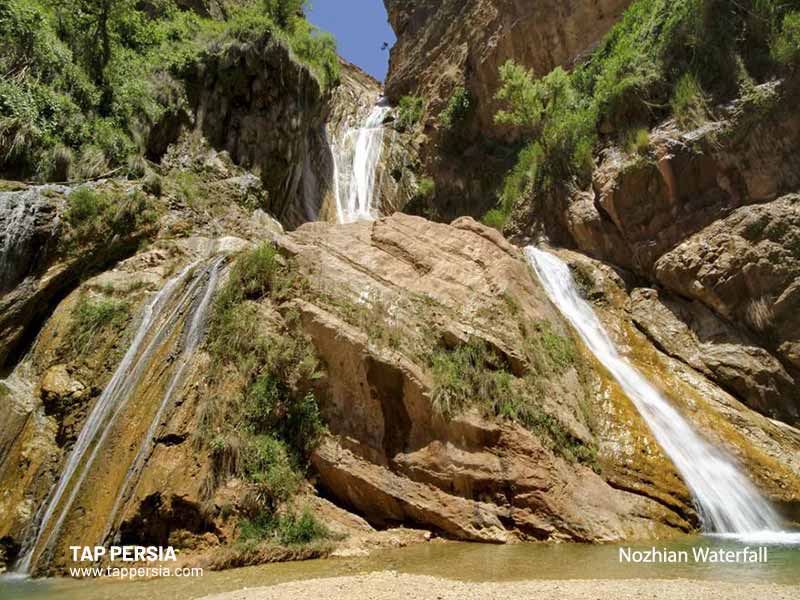
If you are into adventure and trips to beautiful natural areas and you are also interested in waterfalls, this is the place for you.
This beautiful waterfall is one of the sights of Lorestan in the east of the province, in the southwest of Aligudarz city. Ab Sefid waterfall experiences its most beautiful state in spring.
This waterfall with a height of about 70 meters is one of the tallest waterfalls in Iran. In the rainy seasons, its crown width reaches up to 15 meters. At other times of the year, the crown of the waterfall is about eight meters wide. Additionally, its mineral water is one of the healthiest and is of high quality.
Azna snow tunnel is one of the most popular sights of Azna in Lorestan province. This tunnel is more than 800 meters long and is one of the most mesmerizing mountain landscapes in the foothills of Iran. It is on Iran’s National Heritage List, as well.
The snow tunnel is one of the natural wonders of Azna with a width of 10 meters and a height of 2.5 to 3 meters. It is naturally formed from the accumulation of thousands of tons of snow and ice in one of the valleys on the slopes of Oshtrankuh Mount in Aznadreh village.
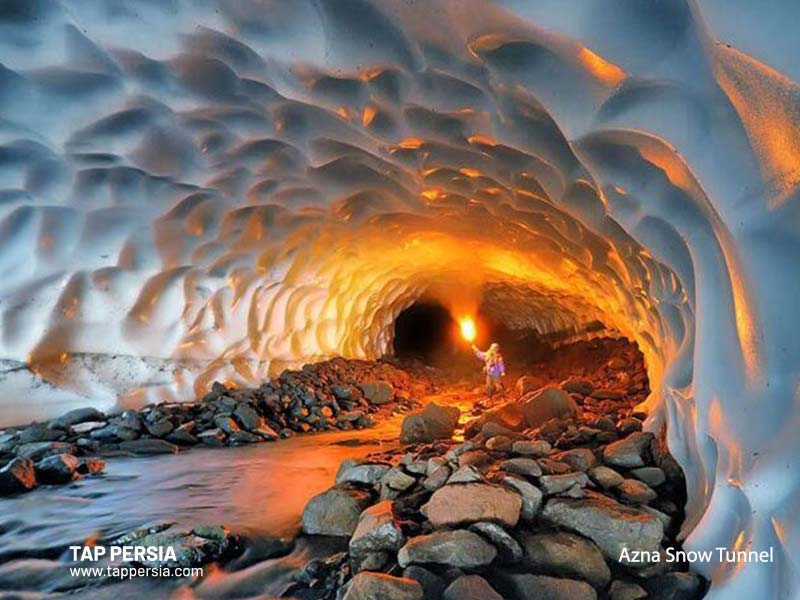 In fact, in the cold season, there are heavy snowfalls in the mountains which form large masses. Then, in the spring the snow starts to melt and water flows through this snow mass. And this creates a beautiful corridor-like space like a tunnel at the bottom of the valley.
In fact, in the cold season, there are heavy snowfalls in the mountains which form large masses. Then, in the spring the snow starts to melt and water flows through this snow mass. And this creates a beautiful corridor-like space like a tunnel at the bottom of the valley.
Despite the beauty, it is dangerous to go inside, of course. Because there is the possibility of the snow tunnel collapsing. Anyway, most tourists still go inside it to have a wonderful and unique experience.
You can visit Makhmal Kuh Forest Park with an area of 475 hectares in the north of Khorramabad. The Makhmal Kuh cliffs are covered with lichens. And with the start of the rainy season, these lichens turn blackish-green which seems like velvet. For this reason, this area is known as Makhmal Kuh (Velvet Mountain).
Makhmal Kuh Forest Park is one of the popular destinations and sights of Khorramabad, which hosts tourists all year round. Hiking, picnicking, and mountaineering are some of the attractions in this area. Some of the attractions here include the Shabikhoon Valley and the Shabikhoon Waterfall. You can find this park at 15 km of the route from Khorramabad to Aleshtar. The park also has facilities such as a restaurant, cafe and so on.
The height of Garmeh Waterfall is more than 20 meters and its crown width reaches 10 meters. You can visit this waterfall near the famous Bisheh waterfall. It’s only 10 km from Bisheh Falls.
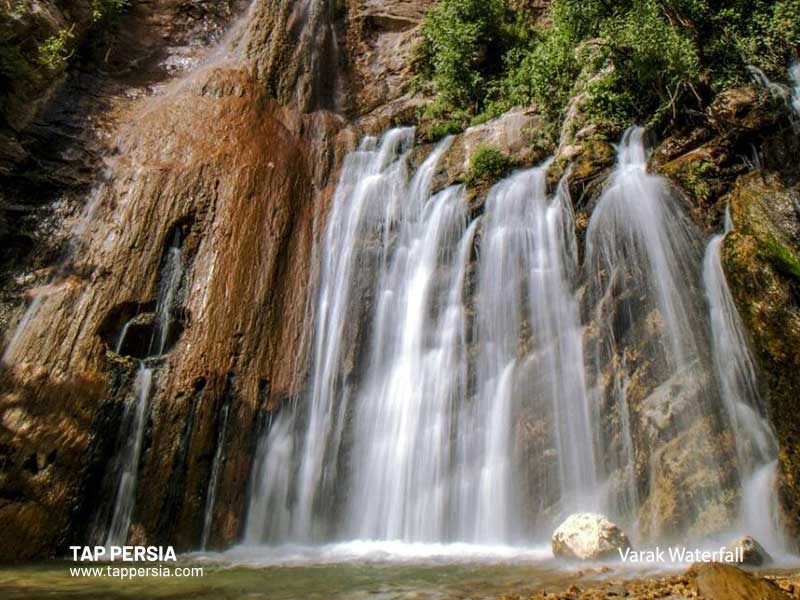
Wark waterfall is located in the southeast of Khorramabad and in the west of Nozhian valley in Wark village. This waterfall is a type of twin or two-story waterfall. The two floors are 15 km apart. The height of Wark Fall is 57 meters.
This height includes the main waterfall and the Wark Stepped falls. What distinguishes Wark Falls from other waterfalls is its wide crown, which reaches more than 50 meters.
Oshtrankooh is a mountain range near Azna city in Lorestan, which is 50 km long. Oshtrankooh is undoubtedly one of the most beautiful mountains in Iran and one of the sights of Azna. Additionally, it has many natural and permanent glaciers. The highest peak of Oshtrankooh is the peak known as Chal Kaboud, which is about 4100 meters high.
You can Visit Bam-e Lorestan or the Roof of Lorestan in the east of Khorramabad and at the exit of the city towards Doroud, on the top of Madaba Mountain. You can see a beautiful and extraordinary view of the city and surroundings. The convenient location and view of the city led to the idea of constructing the Lorestan roof complex.
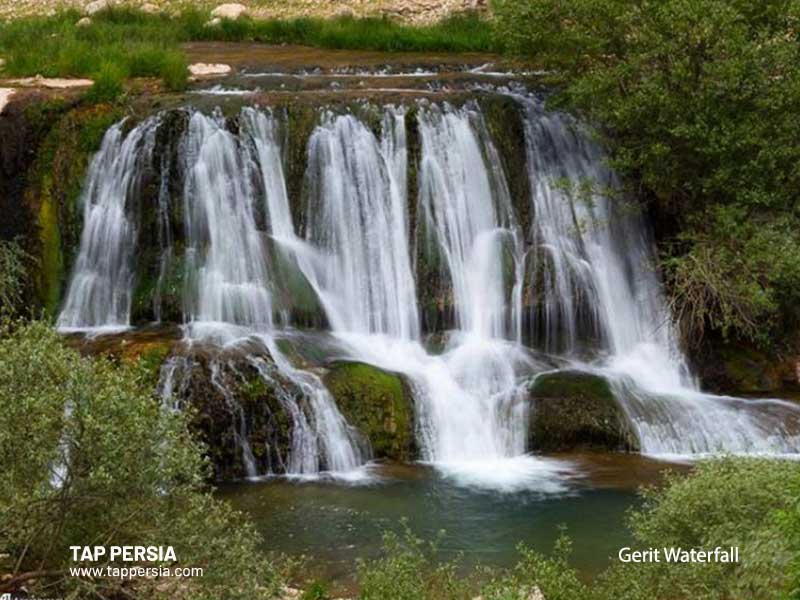 Grit or Sarkaneh waterfall, or Taf Haft Cheshmeh in the local dialect, is one of the waterfalls of Lorestan, in a mountainous and forest area. You can find Gerit Waterfall 50 km southeast of Khorramabad in the village of Gerit.
Grit or Sarkaneh waterfall, or Taf Haft Cheshmeh in the local dialect, is one of the waterfalls of Lorestan, in a mountainous and forest area. You can find Gerit Waterfall 50 km southeast of Khorramabad in the village of Gerit.
If you are a hiker or you like hiking, you can take a one-hour walk from Gerit Village to the waterfall. This route is full of beauty and spectacular scenery that you will surely enjoy watching. In a pleasant valley, among the dense forest trees such as oak, and so on you reach the waterfall. This waterfall consists of three small and large waterfalls that are located at a distance of two kilometers from each other.
Karkheh River is the third-longest river in Iran after Karun and Sefidrud. This river originates from the Zagros Mountains and after passing through Andimeshk city, it changes its route to the west along with the ancient monuments of Susa.
In the northwest of Boroujerd city and at the end of Goldasht road, there is the Kapargeh Valley. It is one of the tourist destinations and sights of Boroujerd in Lorestan province. After passing the villages of Sheikh Miri, you can see Kapergeh 1, Kapergeh 2, Kapergeh 3, and it continues to Vanaee village.
The Valley has a permanent river with many twists and turns that you can only cross on foot or by bike. This valley is one of the best and most beautiful mountaineering routes for Boroujerdi mountaineers. It, also, has two hot springs, a stone bridge, and a cave, named hidden cave.
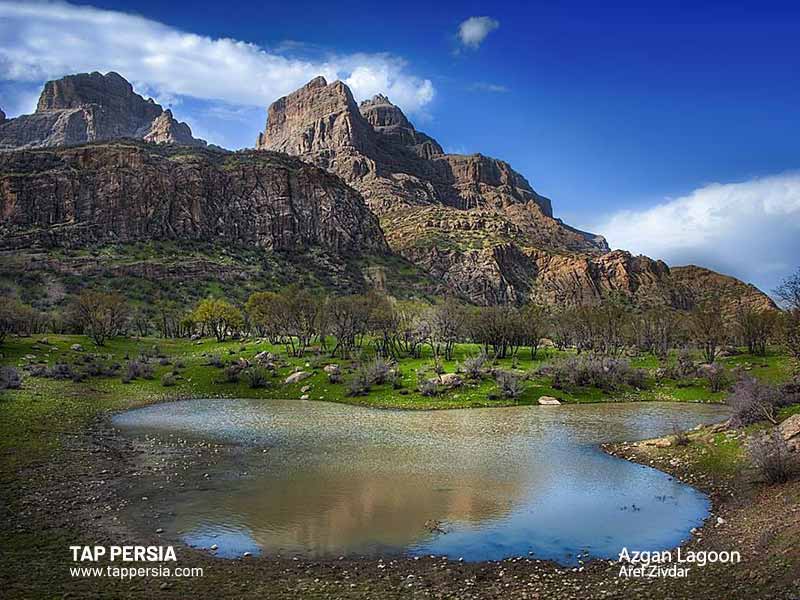
Chakan waterfall is one of the natural attractions of Lorestan province, on the slopes of Zagros, southwest of Aligudarz, in the village of Chekan. This waterfall has a height of 30 meters and a width of 4 meters.
Azgan Lagoon, also known as Qarun Lagoon, is located at the foot of Pariz Mountain in Doroud Village. This lagoon is seasonal and generally has water until late spring and then dries. It is formed by the accumulation of rainwater or the melting of snow on the slopes of Qarun Mountain. It is also one of the sights of Doroud, it offers a beautiful view.
Doosheh Cave is a cave with a history of more than 8,000 years. Interestingly, there are 110 drawings on the walls of the cave drawn by early humans. You can go visit this cave, in Karshoorab city in the west of the province. This cave shows that the history of murals in Iran dates back to the Neolithic period and about 4500 BC. Doosheh Cave is a historical and natural monument and is on Iran’s National Heritage List.
Chagha recreational hill, or Bam-e Boroujerd, is one of the most important recreational places and sights in this city. There are lots of amenities and recreational facilities that make it possible for anyone to enjoy this place. On Chagha hill, there are beautiful statues of mythical characters such as “Arash Kamangir“. You can also enjoy the artificial lake, multi-star hotel, and other charming features.
Sarab Kartol or Kartil spring is one of the promenades and tourist attractions of Boroujerd, in the northwest of the city. You can visit this spring in the foothills of the Garin Mountains. It hosts many travelers and locals all year round.
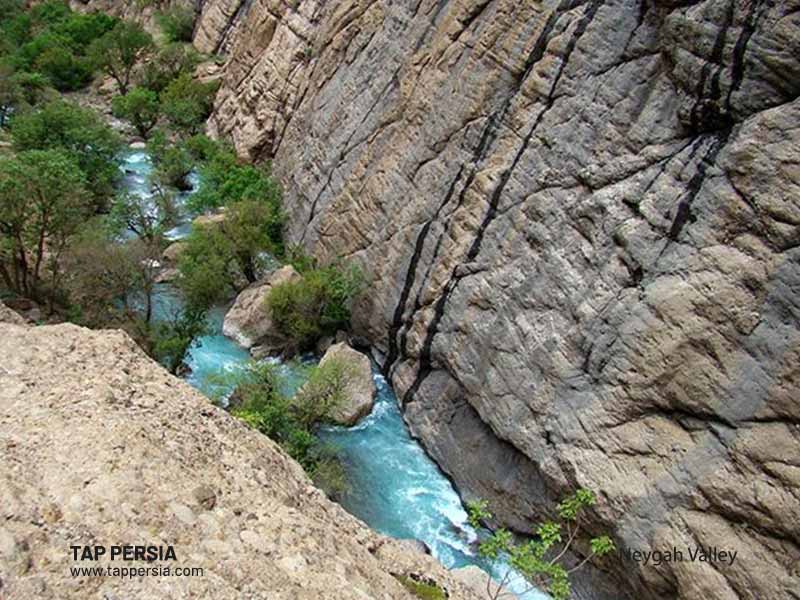
Sefid Ab River originates from Gohar Lake and after a distance of several kilometers, it enters Neygah Valley. Neygah Valley is a beautiful and untouched valley that is one of the protected areas of Doroud.
The valley is about 12 km long and its average width is about 500 meters, although, in some places, its width reduces significantly. “Neygah” valley, also known as “Negar” valley, is a rocky valley in which there is considerable vegetation.
To visit Botkhaneh Cave, you need to go 18 km southeast of Kuhdasht city. Part of the mouth of the cave is closed due to natural causes. But part of it remains open that you can only enter by crawling. The length of the cave mouth is 18 meters and the height of the roof is about 20 meters. The entire roof and walls are white due to the infiltration of water from the limestone layers.
The presence of flint and broken black and painted pottery confirms the cave life in this area.
Aali Abad Cave, in the Kuhdasht region, has been one of the settlements of prehistoric humans. The cave goes down to a depth of 420 meters. This cave is one of the tourist attractions of Kuhdasht, which requires complete technical equipment to visit.
Silakhor plain is one of the tourist attractions of Lorestan province. It is the largest flat land in the province. In Silakhor plain, there are many ancient and historical hills that have been inhabited from prehistoric times to the contemporary century.
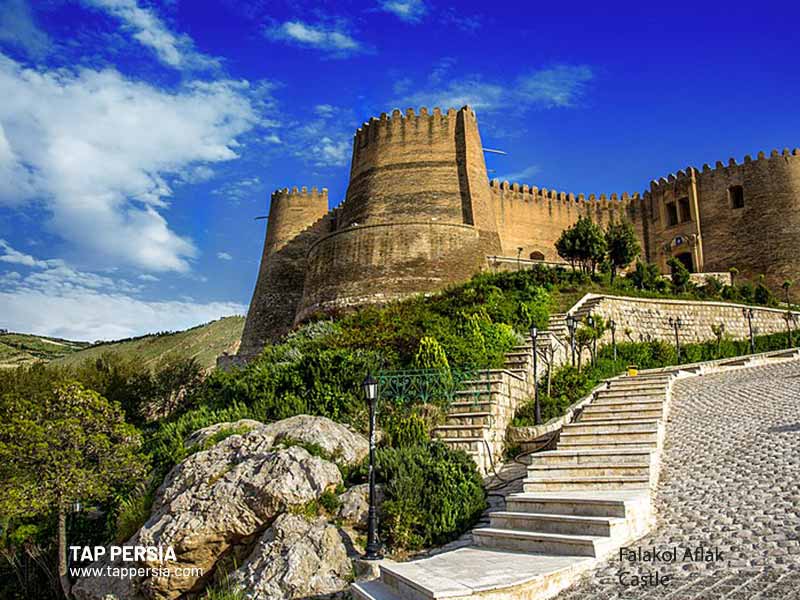
Falak al-Aflak Castle is one of the most famous historical attractions in Lorestan, which most tourists are familiar. This fort, which is also known as Shapur Khast, Atabkan fort, or 12 tower fort, is located on a hill overlooking the city of Khorramabad. Falak al-Aflak fort is on Iran’s National Heritage List.
They built it during the Sassanid period and were used as a command center and residence of the rulers until the Qajar period. This historical monument, which has an asymmetrical octagonal plan with a rectangular pattern, has two courtyards, and 12 towers. And moreover, there are decorations of brickwork, tiling, and stucco arts.
When visiting the castle, you can visit the Lorestan Anthropological Museum, as well, which is inside the castle. In this museum, many works from the customs of the people of Lorestan to the objects of the Achaemenid period are on display.
The Brick Minaret of Khorramabad is another valuable monument of Lorestan. It is about 900 years old and you can visit it in the south of the city. This minaret has about 30 meters in height and the diameter of its lowest part reaches 5.4 meters. There are 99 steps inside the minaret to access the roof. This special monument is on Iran’s National Heritage List, too.
The remains of architectural structures in the vicinity of the minaret show that there were other structures such as caravanserai, a mosque, etc. around it. They used this brick minaret to guide caravans moving towards the city of Shapur Khast so as they do not get lost.
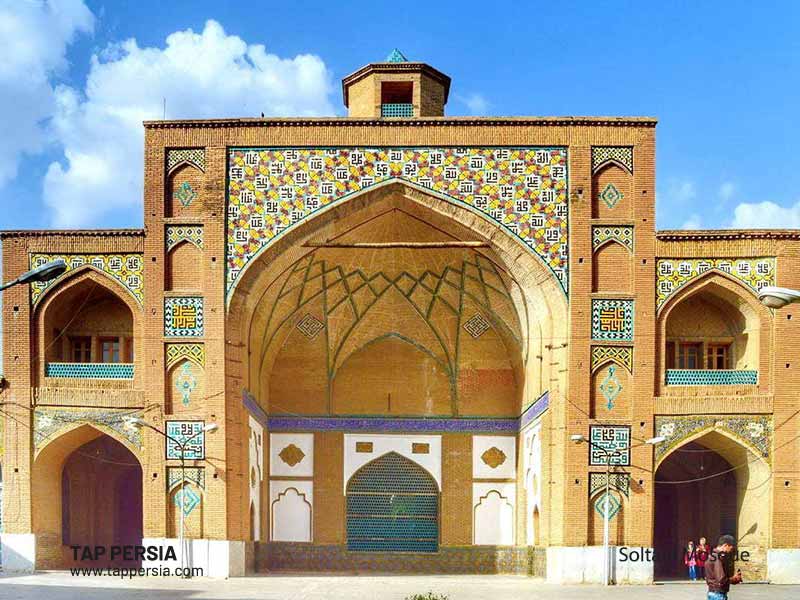 Soltani Mosque, also known as Imam Mosque and Shah Mosque, is one of the historical monuments of Boroujerd. They built this mosque during the reign of Shah Ismail Safavid.
Soltani Mosque, also known as Imam Mosque and Shah Mosque, is one of the historical monuments of Boroujerd. They built this mosque during the reign of Shah Ismail Safavid.
This four-Iwan mosque with an area of more than 7,000 square meters is the largest historical mosque in western Iran. There are numerous inscriptions made of plaster, stone, and wood in the mosque to decorate it.
The Gerdab Sangi or Gardow Bardineh is a circular structure that they built using stones and mortar around a spring. So that they can control the water coming out of the spring and deliver it to different parts of the city through a water canal. This historical monument, in the northwest of Khorramabad, belongs to the Sassanid period.
It is also on Iran’s National Heritage List.
Boroujerd Grand Mosque is one of the unique mosques of Lorestan and one of the sights of Boroujerd. They say they built this mosque in the second and third lunar centuries by manipulating a large Sassanid fire temple. After the arrival of Islam in Iran and its officialization, many Zoroastrian religious sites and fire temples naturally turned into mosques. Therefore, the Boroujerd Grand Mosque may have been one of them. The Boroujerd Grand Mosque still retains many unknowns. However, they know it dates back to the Buyid dynasty.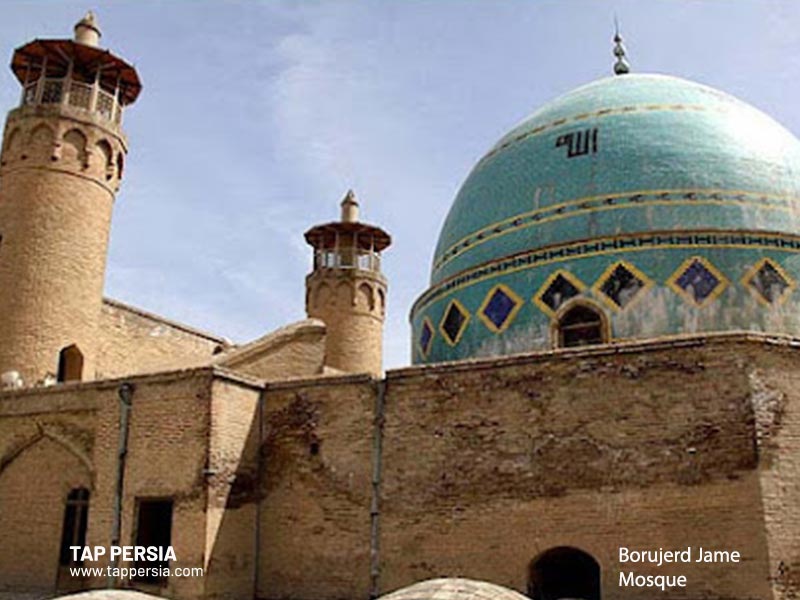
Gap Historical Bath is one of the surviving buildings of the Safavid period and the sights of Khorramabad. You can find it near Gap Square in the city center. The spectacular decorations of this building fascinate every viewer.
Tappeh Qoroq or Ghorogh Hill is one of the most important historical monuments and places of interest in Boroujerd. This historical monument has a history belonging to the Copper Age or the Neolithic Age in the fifth and fourth millennium BC. That’s why they introduced it as the most important ancient hill in Boroujerd city.
It is also on Iran’s National Heritage List.
As the name of Khorramabad Shapouri Bridge indicates, this bridge is one of the buildings belonging to the Sassanid period. At a distance of one kilometer from Shapouri Bridge, there is the castle of Falak al-Aflak; Experts and archaeologists believe that they built the two buildings at the same time.
Shapoori Bridge, which is known as Broken Bridge, due to the damage done to it by natural factors, is one of the largest stone bridges in Iran. During the Sassanid period, the Shapouri Bridge was used for the passage of Iranian caravans and troops from Susa to Hegmataneh ( Hamedan).
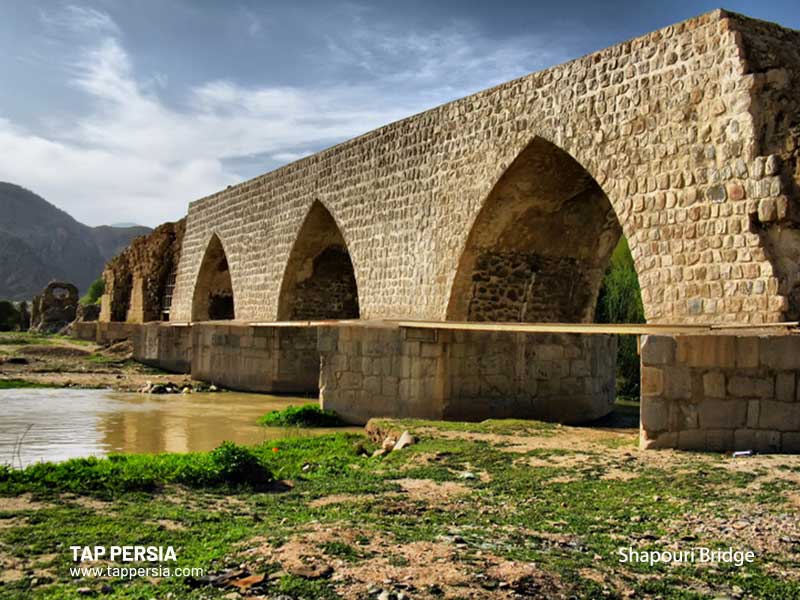 This prominent bridge once connected the west of Lorestan province to the east. And from there Lorestan province had access to Khuzestan and Ctesiphon, the capital of the Sassanids.
This prominent bridge once connected the west of Lorestan province to the east. And from there Lorestan province had access to Khuzestan and Ctesiphon, the capital of the Sassanids.
The rock carvings of Homiyan, which is one of the sights of Kuhdasht, have been engraved on a cave in the north of Kuhdasht city, in the northwest of Lorestan province. Thre is no information about the exact time that these shapes belong. But it is likely that they are related to the Paleolithic period.
These motifs usually depict the aspirations of the painter. The existence of these motifs indicates the longevity of human habitation in these areas. The rock carvings of the Homiyans begin with the drawings of the ship’s anchor, and then turn to the deer hunting grounds. The number of these motifs is 10 in Homiyan Cave and 18 in Mirmalas Valley, most of which are painted in black and yellow.
Manizheh or Manijeh historical castle is one of the tourist attractions of Kuhdasht. The length of the fortress of the castle exceeds 100 meters. in the northern part of it, there are several rooms. The general area of the castle is about 2500 square meters. In the southern part of the rooms, you can see the remains of a large water reservoir. The walls of this reservoir were plastered.
The importance of this castle is its dominance over the surrounding valleys. Moreover, its wide view is interesting, which amazes viewers and tourists. Inside the castle, there is a strange and interesting tunnel, the opening of which has a steep slope up to 10 meters to the east and south and is 15 meters deep.
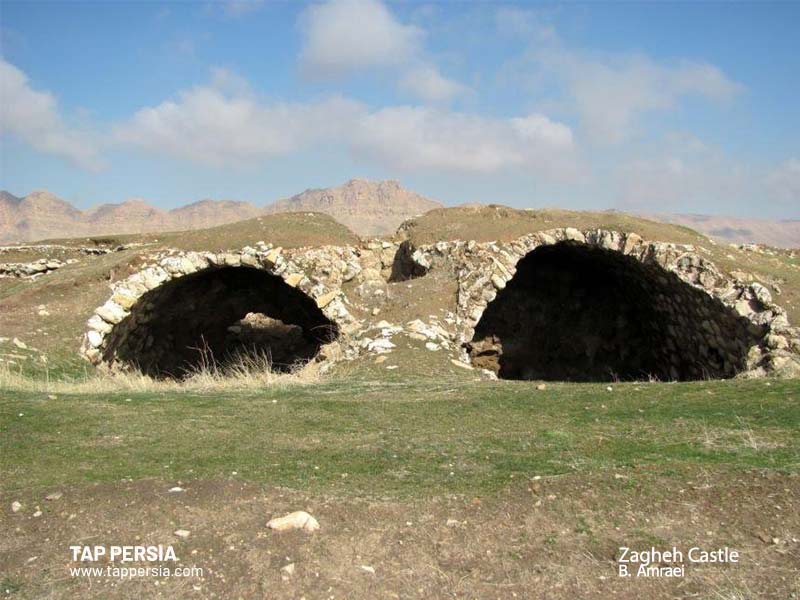
Zagheh Castle (Zakheh Castle), in the city of Kuhdasht, is made entirely of stone. The style and type of the arch are different from other structures in the province. The stones they used in this building are carved and rubble.
This castle is one of the sights of Kuhdasht, and some consider it one of the structures of the Elamite period. But the building has most of the features of Sassanid architecture. Most of it is buried underground. There probably was a fire temple in the southern part, as well.
The ancient temple of Sorkh Dam Laki is a historical area, six kilometers northwest of Kuhdasht, at the foot of Mount Changari. They have discovered numerous historical artifacts and objects from the first historic period of the first millennium BC in this region.
The objects they found are carved stones with the role of winged lion and tree of life, as well as glazed pottery pieces with carvings that belong to the 7th and 8th centuries AH. Archaeological excavations in this area started in 1998 and continue to this day.
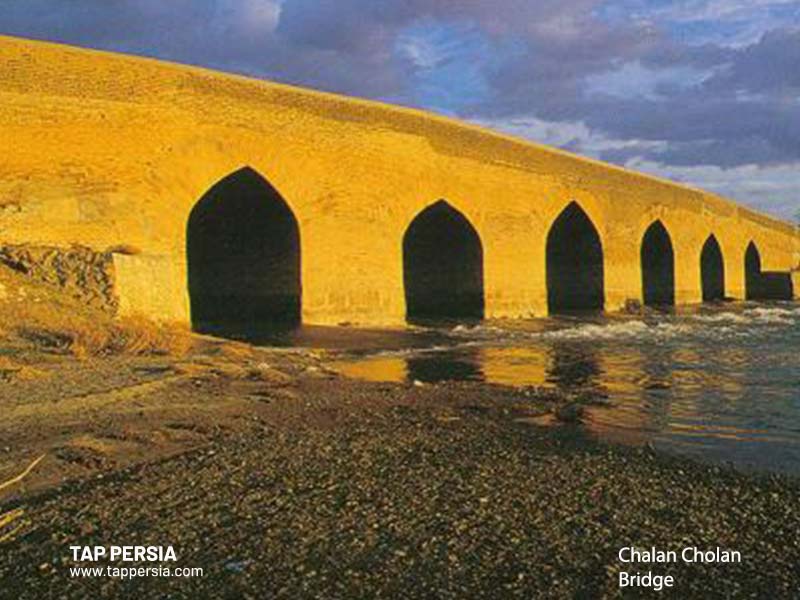
You can find the ancient site of Sorkh Dam Lori 10 km southeast of Kuhdasht in the Lakestan region. They call it Sorkh Dom because of the red soil on the slopes of the mountain. In addition to a temple on this site, they discovered structures that seem they used for short-term stays.
Dr. Schmidt was the one who excavated this huge ancient site for the first time. And what they found was particularly important for the researchers. This temple has an Assyrian style because at that point in time Lorestan was under the intense influence of Assyrian art.
Chalan Cholan Bridge dates back to the Qajar period. It is one of the historical monuments and places of interest in Boroujerd, on the Boroujerd-Khorramabad road. Chalan Cholan Bridge is 120 meters long and has six brick arches. The stone foundation is up to one meter high and the body of the bridge is made of brick.